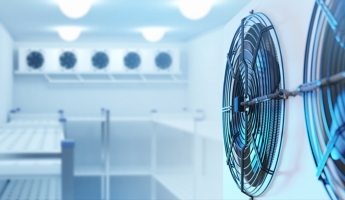How to stay safe when working in cold rooms
Listed Under: Blog
Cold rooms. They’re cold. That’s their job.
Cold rooms are a kitchen staple for storing large quantities of fresh produce, meats, dairy products, and more. Unlike smaller fridges or counters, they offer walk-in space that makes grabbing ingredients quick and easy while keeping everything at the right temperature.
Usually kept between 0 °C and 4 °C for chilled goods (or much colder for freezers), cold rooms are ideal for busy restaurants and catering businesses with frequent deliveries.
But even though staff only spend short bursts inside, cold rooms present unique challenges to safety. Here’s how to address them.
#1 Avoid getting locked in
In extreme (and very rare) cases, getting locked inside a cold room is potentially life-threatening, especially if someone is working alone and is using a freezer room. Limited air circulation and dropping temperatures quickly become hazardous if you can’t get out. To prevent this:
- Never close the door while someone’s inside.
- Make sure everyone always checks the door seal and locking mechanism before entering.
- Ensure the cold room is equipped with an internal emergency release handle and confirm it functions properly on a regular basis. (Set up an inspection chart to be signed off every month.)
- Keep clutter away from the outside of the door so that nothing falls and blocks it while someone is inside.
- Never prop the door shut from the outside. This might prevent someone from opening it from inside.
If you do find yourself locked in, stay calm, locate the emergency release handle, and leave. If you’re still stuck, call for help using your phone or any available communication device.
Consider having an emergency communication method inside for added safety. This isn’t standard practice, but it can’t hurt.
#2 Plan your movements and minimise time inside
Cold rooms are cold for a reason – to keep your food safe and fresh. But spending too long in these chilly environments can lead to discomfort and even health risks like numbness or muscle stiffness.
In most cases, there’s nothing to worry about. However, encourage staff to plan ahead before entering. They should know exactly what they need and where it’s stored. This way, they can enter and exit quickly without rushing and risking accidents.
If you need to restock or retrieve large amounts, consider breaking the task into smaller trips.
#3 Keep pathways clear and floors dry
The cold room floor might get slippery due to condensation or spills. Clean up any spills right away, and if you notice persistent moisture, report it so it can be addressed. Have a reporting system there and ready to use, so people know where to turn. Wearing non-slip shoes can also make a big difference.
In the same vein, keep the aisles and entryways clear of boxes, pallets, or any other items that might trip someone up.
#4 Use safe lifting techniques
Cold rooms often mean bulky boxes or heavy bags of produce. Use your legs, not your back, when lifting. Keep loads manageable, and ask for help with anything too heavy or awkward. Using trolleys or carts where possible can reduce strain and improve safety.
#5 Dress sensibly for the cold room
You don’t need to dress like an Arctic explorer to work safely in a kitchen cold room. But if someone’s spending a significant amount of time in there (for example, doing a stock check), basic adjustments can make their time inside more comfortable and reduce risks. A simple, lightweight, insulated jacket or jumper is usually enough to keep you warm during short trips in and out of the cold room.
Wear gloves when handling frozen or chilled items to protect your hands from the cold and prevent slips, but make sure they still allow you to grip boxes and tubs securely. And as mentioned before, non-slip, closed-toe shoes are essential to prevent accidents on potentially wet floors.
Nothing too crazy, but thin, practical layers might make things more comfortable.
#6 Know what to do in an emergency
Cold rooms can be disorienting, especially if you’re in there alone. Make sure you know where the emergency release handles are and that they work properly. Always keep your mobile phone or a communication device close by if possible, so you can call for help if needed. If you ever feel unwell or too cold, leave immediately and alert your supervisor.
Get your cold room from Fridgesmart
Working safely in a cold room is mostly about staying aware and prepared. Minor changes to how you approach your tasks and dress make a big difference in comfort and accident prevention. And remember – if your cold room feels too cramped, unsafe, or unreliable, it might be time to think about upgrading to a better, more efficient model.
At Fridgesmart, we supply commercial cold rooms designed to meet your kitchen’s specific needs, featuring stainless steel floors, heated door frames, and sturdy shelving to make your team’s work easier and safer.
Interested in upgrading? Browse our range online or contact us for expert advice on choosing the right cold room for your business.

 loading...
loading...